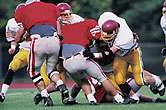College athlete deaths in workouts spur new guidelines

(HealthDay) -- The sudden death of a growing number of college athletes during conditioning sessions has prompted a task force, led by the National Athletic Trainers' Association (NATA), to issue new safety recommendations for these workouts.
NATA said the guidelines are designed to provide doctors, trainers, coaches and athletes with ways to prevent sudden deaths among young athletes, particularly those with underlying heart conditions.
"Strength and conditioning sessions have become fundamental to success in collegiate sports," task force chair Douglas Casa, director of athletic training at University of Connecticut Neag School of Education, and chief operating officer of the Korey Stringer Institute, noted in an NATA news release. "However, the athletes' development, health and safety are sometimes overshadowed by a culture that values making athletes tough, instilling discipline and focusing on success at all costs. This ill-conceived philosophy has been a contributor to the alarming increase in collegiate athlete deaths and serious injuries during conditioning sessions."
Over the past 12 years, 21 National Collegiate Athletic Association (NCAA) football players died during conditioning sessions, which typically involve activities such as sprinting, lifting weights and mat drills. Of these deaths, 75 percent involved Division 1 players. NATA noted 11 of the athletes died during the first or second day of training, suggesting they did not have enough time to get used to their workouts.
Rodger Saffold, an offensive tackle with the St. Louis Rams who was drafted from Indiana University three years ago, admitted that athletes often overexert themselves, so it's critical for trainers and coaches to provide guidance to ensure their safety.
"As a former collegiate player, I often pushed myself too far. . . These guidelines today will prevent just that and I'm glad to be a part of such an important forum," said Saffold.
The new guidelines, entitled "Preventing Sudden Death in Collegiate Conditioning Sessions: Best Practices Recommendations," make the following recommendations to prevent injuries and death among amateur athletes during conditioning sessions:
- Introduce new conditioning activities gradually and allow athletes to acclimate.
- Exercise and conditioning activities should not be used as punishment.
- Strength and conditioning coaches must have the proper education, experience and credentials.
- Athletes must have medical supervision, including a strength and conditioning coach and athletic trainer.
- An emergency action plan must be developed and tested.
- Coaches and staff must be prepared to provide first aid as soon as an athlete shows signs of distress.
- Coaches and staff must be aware of athletes' medical conditions.
- Health and safety concerns for student athletes must be managed during strength and conditioning workouts.
- A working partnership should be established with recognized professional organizations, including athletic, coaching, sports medicine and strength and conditioning organizations.
- Coaches and their medical staff must complete adequate continuing education.
"It's vital that we administer collegiate conditioning sessions with appropriate oversight by educated and experienced strength and conditioning coaches. They, in turn, should work in collaboration with athletic trainers and team physicians and follow an adhered to plan of gradual acclimatization to each workout session," task force member Jay Hoffman, president of the National Strength and Conditioning Association, said in the news release.
The task force noted that following the new recommendations on conditioning workouts would also lower the liability of a school or its organization's administrators, teams and coaches.
Commenting on the guidelines, Richard Adler, a founding principal partner of the Seattle law firm Adler Giersch and chairman of the executive board of the Brain Injury Association of Washington, said in the news release: "These guidelines are a great resource to prevent easily preventable tragic and catastrophic deaths, reduce financial and legal risks, and make sports more enjoyable for participants, their families and fans."
The task force was comprised of several organizations including the American College of Emergency Physicians, the American Medical Society for Sports Medicine, the American Orthopaedic Society for Sports Medicine, the National Collegiate Athletic Association and the United States Olympic Committee.
The task force guidelines were presented Wednesday during NATA's annual meeting in St. Louis. They will also be published in the July/August issue of the Journal of Athletic Training.
More information:
The U.S. National Heart, Lung, and Blood Institute has more about sudden cardiac arrest.
Copyright © 2012 HealthDay. All rights reserved.


















